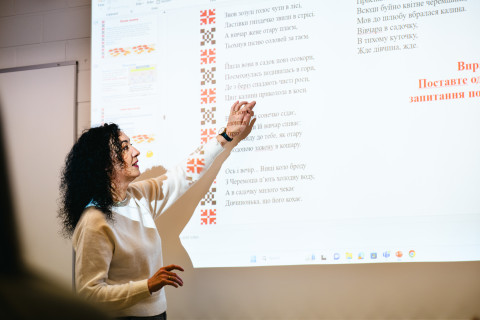The University of Eastern Finland has come up with an effective way to teach the Ukrainian language and culture.
“Singing is an easy way to take things in and memorise them. Before written language evolved, young people would learn the laws, myths and previous historical events of their community through song. This still happens in some cultures, for example in some parts of Australia and Africa,” Professor of Russian Language Larisa Leisiö says.
She is one of the teachers in charge of the Ukrainian Language and Culture in Songs course, which is funded by the Kone Foundation. The course is elective and now running for the second time, and the number of students now interested in the course took the teachers by surprise.
“People really haven’t changed that much in the course of history, but I think our pedagogical culture has distanced itself from people. Song is rarely used in the teaching of foreign languages and, I guess, even less frequently in the teaching of other subjects.”
However, songs are a great way to learn a language and culture, as words and expressions get repeated over and over again. In addition, song verses often follow a similar structure, so they are easier to remember than phrases learned from separate and often invented sentences.
“On this course, we make use of old folk songs, whose easy and practical words and expressions have been polished over the decades,” Leisiö explains.
Through these songs, students can easily get acquainted with Ukrainian customs and art as well.

Relaxed and interesting studying
“On each lesson, we familiarise ourselves with a new song. We listen to the words, their order and what the song is about. We also think about how the song relates to Ukrainian culture,” says student Henri Rästas, describing the course.
“In other words, we analyse the songs both in terms of their content and grammar,” Rästas’s fellow student Ville Kuvaja adds.
Both are third-year students majoring in the Russian language. Previous knowledge of Russian is a prerequisite for the course in Ukrainian, making it easier and faster to get a grasp of the language. The Ukrainian and Russian languages are closely related, so students can, to some extent, follow and understand the songs already at the beginning of the course.
Rästas says he can keep up with everyday conversations in Ukrainian but, compared to Russian, the language has so many distinctive features that a deeper knowledge of it is more difficult to attain.
“Because the course is elective, studying is more relaxed in any case. All of us are taking the course purely out of interest in the language and culture, without any major pressures,” says Kuvaja.

A broader study programme would respond to current needs
The number of applicants for Russian language has decreased at the University of Eastern Finland since 2022, when Russia began its war of aggression. However, most students who have chosen to study Russian since are very motivated.
“Besides Finnish-speaking students, we also have Russian-speaking students and those who speak Russian as a second language at home. The war doesn’t seem to have much of an impact on these students’ choices in the future, either. We also have Ukrainian students who have moved here long before the war, and Finnish students who have Ukrainian or Russian roots,” says Larisa Leisiö.
According to her, understanding the Russian language and culture is very topical and necessary right now. Russia and Russian people are talked about in the media almost daily, and experts on the matter are urgently needed. However, Leisiö feels that language education provided by the university should be more responsive to current needs.
“I strongly believe that the name and content of our subject should be changed from ‘Russian language and culture’ to ‘East Slavic languages and cultures’. Our graduates would thus have a Master’s degree in East Slavic languages and cultures.”
Of course, this would require an expansion of the study programme to include not only Russian, but also Ukrainian and, at some point, Belarusian as well. The curriculum should also include the history of Ukraine and Belarus as regions, states and cultural areas.
Leisiö points out that peace will eventually prevail, and the need to understand East Slavic languages and mentalities will greatly increase in Europe – not only in Finland.
“East Slavic languages are very closely related, and knowledge of one language greatly supports the study of another. Having such a study programme would broaden the perception and understanding of language relations and language history.”
Peace will eventually prevail, and the need to understand East Slavic languages and mentalities will greatly increase in Europe – not only in Finland.
Larisa Leisiö
Professor
A novel perspective could be of international interest
According to Leisiö, there are relatively few degree-awarding programmes in the Russian language in, e.g., the Baltic countries.
“This is why I believe that an international Master’s degree programme in East Slavic languages and cultures would be an attractive package, attracting interest from our neighbouring EU countries and perhaps even from the United States.”
Rästas and Kuvaja agree. According to them, such a study programme sounds tempting.
“The reform would probably not concern us in any way, but a broader study programme would certainly arouse new kind of interest in Russian language studies as well.”
The Ukrainian Language and Culture in Songs course is part of the Language Bridge between Ukraine and Finland project (2023–2025) funded by the Kone Foundation.



